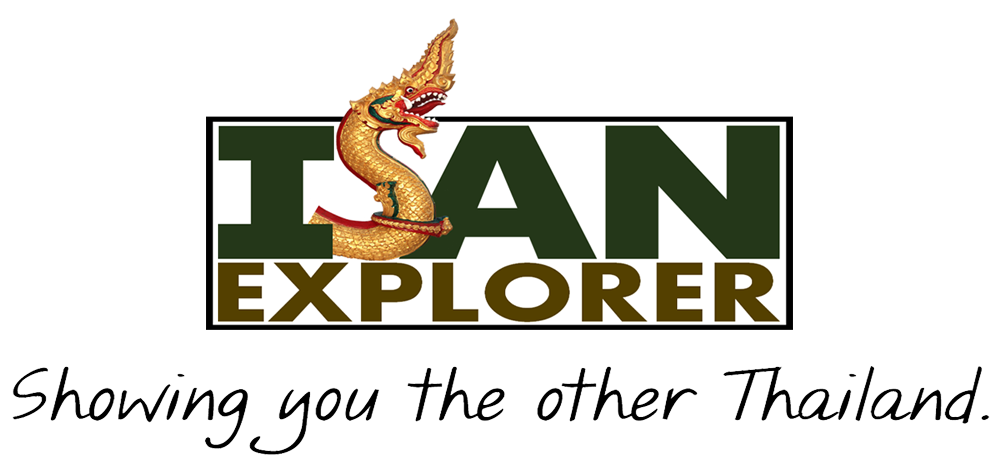Thailand Background

Geography
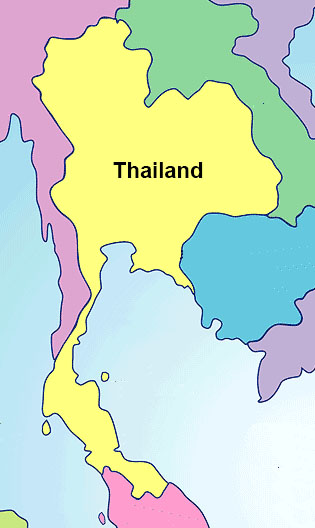
With a shape roughly resembling an elephant’s head (Thais see it as a “golden axe”), Thailand is nestled between Myanmar, Laos, and Cambodia with the trunk abutting Malaysia in the far south. It covers 513,120 sq. kilometers (198,117 sq. miles); about the same size as Spain and twice the size of Oregon and has 3,219 kilometers (2000 miles) of coastline.
Thailand has four geographically distinct regions. The Northeast (Isan, also often spelled Isaan) sits on the semi-arid Khorat Plateau and covers about 1/3 of the country. The North is mostly mountainous with Doi Inthanon (2,576 meters; 8,451 feet) the nation’s highest point. The fertile Center follows the Chao Phraya River, which empties into the Pacific Ocean near Bangkok, and is the primary producer of rice. The South stretches for almost 1000 kilometers (621 miles) between the Andaman Sea and the Gulf of Thailand and is lined with many beautiful beaches and islands.
Thailand has 77 provinces (Technically, it’s 76 plus Bangkok, which is a special district.) each having a capital city sharing the province’s name. Bangkok (The Thai name is Grung Thep: “City of Angles”) is the political capital and heart of all things commercial and cultural.
History
In the Beginning

Evidence of hunter-gatherers has been found from 180,000 years ago and a relatively advanced society developed in the Northeast likely around 2000 BC. These peoples may have been the world’s first farmers and the bronze tools unearthed at Ban Chiang date show this is where the Bronze Age began in East Asia. By the last century BC, communities across the whole of the land that now constitutes Thailand had trade contact with India and large settlements began to grow on the Malay Peninsula. Theravada Buddhism likely arrived around the 6th century AD when the Mon people’s Dvaravati empire, probably based at Nakhon Phathom, held sway over much of Thailand and adopted many ideas from India.
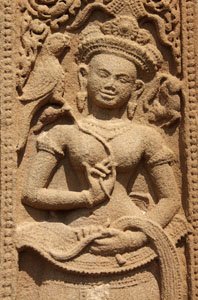
Scholars widely hold to the theory that the Tai ethnic group (which includes the “Thai” people) originated in southeastern China and then migrated across Southeast Asia, entering Thailand around the turn of the second millennium. Though they had a reputation as excellent warriors they managed to coexist with rather than conquer most of their new neighbors and over time many local peoples assimilated into Tai culture. About the same time the Tai arrived peacefully from the north the Khmer empire of Angkor invaded from the south, slowly replacing the Dvaravati civilization in most places and exerting a powerful influence on language, culture, and religion (the Khmers were principally Hindu) that remains strong today. Southern Thailand at this time was part of the powerful, Sumatra-based Srivijaya empire.
The Dawn of Thailand
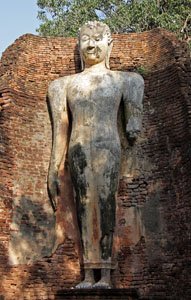
What can be considered the birth of Thailand began in the 13th century when people rebelled against the weakened Khmers and the Lan Na (“Million Rice Fields”) and Sukhothai (“Dawn of Happiness”) kingdoms emerged in the north. Sukhothai was annexed by another Thai kingdom, Ayutthaya, in 1378, but before the end of its relatively short run it had laid the groundwork for a Thai national identity and the Thais of today regard it as the first genuine Thai kingdom. Unlike the paternalistic and benevolent model followed by the monarchs in Sukhothai, Ayutthaya’s rulers declared themselves god-kings and for most of the kingdom’s history they ruled with absolute authority. Ayutthaya was very successful militarily and even conquered Angkor in 1431, but it grew truly great as a trade center (Though located well up the Chao Phraya River, the capital city was an international seaport and hosted residents from around the world.) and for the second half of its reign the capital was one of the world’s wealthiest and most cosmopolitan cities and it dedicated itself more to raising temples than armies. The Burmese, centuries-old enemies of Siam, captured Ayutthaya 1767, thoroughly destroying the capital city and carting of the royal family off to Burma.
A New Beginning
Though the Burmese had ended a 416-year dynasty, they only maintained their hold for a few months before being driven back by Phraya Taksin, a half-Chinese, half-Thai general. He then declared himself king and established a new capital down the Chao Phraya in Thonburi; though when he decided that he was the next Buddha his inner circle had him executed and Chao Phraya Chakri (Rama I; ruled 1782-1809) took the throne. And so was born the dynasty that rules today. He moved the capital just across the river to the more easily defensible Ratanakosin (present-day Bangkok) and began a tenacious drive to restore the artistic and cultural heritage of Ayutthaya and also aggressively expand the kingdom’s borders. His next two successors Kings Phutthaloetla Naphalai (Rama II; ruled 1809-1824) and Nang Klao (Rama III; ruled 1824-1851) continued these efforts.

King Mongkut (Rama IV; ruled 1851-1868), who had lived as a monk for 26 years and was the first king to show his face to commoners, and King Chulalongkorn (Rama V; ruled 1868-1910) both focused on modernization, and in many ways this meant Westernization. Diplomatic and trade relations were established with the United States and many European nations and they encouraged scientific thinking. Chulalongkorn was almost radical in his reforms which included the abolishment of slavery, the establishment of European-style school and court systems, and the construction of railways. All the while the two negotiated and maneuvered to make Thailand the only Southeast Asian nation to never be colonized by a European country; though they strategically ceded a lot of territory in what are now Laos, Cambodia, and Malaysia to the French and British to accomplish it. British-educated King Vajiravudh (Rama VI; ruled 1910-25) made education and the adoption of surnames compulsory. The first, but far from final military coup attempt happened in 1912, though it was unsuccessful.
“Democracy”
Twenty years later, a group of young officers and bureaucrats who had been inspired by democratic ideals while studying in Europe forced King Prajadhipok (Rama VII; ruled 1925-35) to accept a transformation of the nation to a British-style constitutional monarchy. The country’s initial foray into democracy was a battle of wills between civilian and military leaders. The latter came out decisively on top and pursued a strongly nationalistic and militaristic path. In 1939 Siam officially became Thailand (Prathet Thai: “The Country of the Thai People.”) and the government sided with Japan during WWII in a calculated move aimed to retrieve some previously ceded territory. There was, however, a strong and organized resistance movement (Seri Thai) led by ordinary Thais.
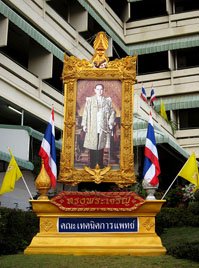
Since 1946, when King Bhumibol Adulyadej (Rama IX; ruled 1946-2016) ascended the throne – following the unexplained death of his beloved older brother King Ananda Mahidol (Rama VIII; 1935-1946) by gunshot in his own bedroom – Thailand has repeatedly drifted between something resembling democracy (Thailand is really a classic example of a plutocracy) and military dictatorship. While its politics have been turbulent, life has mostly been peaceful, which is in contrast to the decades of civil strife in neighboring countries. While there were violent suppressions of demonstrations calling for democracy in 1973, 1976, and 1992, and more recently multiple large protests against various governments, daily life for most ordinary citizens usually passes by without regard to the machinations of politicians and the elite, who largely operate with impunity.
Up to the Present
Following a severe economic crash in 1997, former police officer turned telecom billionaire Thaksin Shinawatra become prime minister thanks to his Thai Rak Thai (“Thais Love Thais”) political party’s populist policies such as debt relief and cheap universal health care. He became the first prime minister in Thailand to complete a full term, and then during the next election in 2005, Thai Rak Thai won an outright majority in parliament. But, despite his electoral success, Thaksin is quite likely the most polarizing figure ever in Thai history and his opponents’ accusations of corruption, conflict of interest (most notably his US$1.9 billion tax-free sale of his shares in Shin Corp) and a desire to usurp the power of the monarchy reached such a crescendo that in September 2006 he was ousted in Thailand’s 11th successful military coup (out of 20 attempts) since 1912.
A year later the People’s Power Party (PPP), the new political party allied with Thaksin won the election and this revived the “yellow-shirt” anti-Thaksin protests. In 2008 Thaksin and his wife were convicted of corruption (He fled the country before the verdict and remains a fugitive today.) and the PPP was dissolved following controversial court rulings. The opposition Democrat Party was able to piece together a coalition with Abhisit Vejjajiva as prime minister. These events bought out masses of “red-shirt” protesters in support of Thaksin and democracy. To nobody’s surprise, Thaksin’s allies overwhelmingly won the subsequent elections in 2011 with his sister Yingluck becoming a proxy prime minister. But their attempt to pass a broad amnesty bill and their failed rice price-support scheme led to yet another military coup. The military junta wrote a new constitution with elections, but without full democracy.
• To read a full account of Thai history, we recommend the book A History of Thailand by Chris Baker and Pasuk Phongpaichit (Cambridge University Press, 2009).
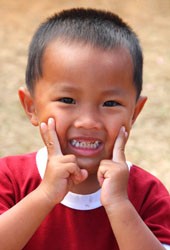
People
Thailand’s population is around 68 million, making it the 21st most populous nation in the world. Over 10% of the population lives in Bangkok, including a huge number of transitory workers from the countryside. Despite the exodus, two-thirds of the population still lives in rural areas. Seventy-five percent of the population is ethnically Thai and 14% is ethnically Chinese. The remaining 11% consists mostly of Mon, Khmer, Burmese, Malay, Indian, and the various hill tribes such as Lahu, Hmong, and Karen who inhabit the mountains of the north. There is also a rapidly growing Western expatriate population since Thailand is a popular retirement destination.
Religion
About 94% of Thais (99% of the people of the Isan region) are Buddhist. Though as in all Buddhist countries, people follow much older Hindu and animistic rituals far more closely than the philosophy of life taught by the Buddha. Religion’s influence on Thai culture is profound and in many places, particularly the countryside, temples still provide social services such as schools and hospitals. Even much of the country’s most cutting edge modern art is rooted in Buddhism. Just about all adult males will ordain as a monk for a short time in their lives; although most do it to fulfill a societal obligation rather than as a serious religious pursuit.
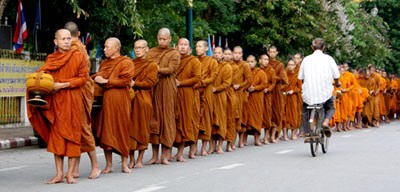
Theravada Buddhism is the official religion of Thailand and it’s taught in schools and directly supported by the government, but Thais respect all faiths and the constitution expressly forbids any laws that impede religious freedom. Muslims, living mostly in the far south, form the largest religious minority at 5.4% of the population while Christians (mostly ethnic Vietnamese and hilltribe peoples) compose 0.9%. There also very small but notable Hindu and Sikh communities.
Government
Thailand is a constitutional monarchy along the lines of the system in the United Kingdom with King Bhumibol Adulyadej (Rama IX) – the “Head of State, Head of the Armed Forces, Upholder of the Buddhist religion, and Defender of all Faiths.” – having the final say in all decisions, though he very rarely exercises this authority. His Majesty took the throne in 1946 making him the longest-reigning monarch in Thailand’s history and the longest-reigning in the world today.
Before the coup, all members of the House of Representatives were chosen in national elections while just under half of senators in the upper house are appointed. Under the new constitution still being drafted, an unelected senate will have final oversight of all matters, keeping the army in total control. Most provincial- and district-level official are appointed and though previously village heads were elected, this has since been eliminated.
Economy

Exports drive the Thai economy, which is the second largest in Southeast Asia after Indonesia, and provide for 60% of the country’s GDP. Agricultural products, mostly rice (Thailand has led the world in rice exports almost every year for many decades.) plus significant amounts of cassava, rubber, and fishery products, are important export commodities. Though rice is still the number one single export item (African countries are the largest purchasers.), these days industrial goods like automobiles, computer components, textiles, shoes, and jewelry bring in the most money. China, Japan, and the USA are the main markets. Agriculture accounts for over 10% of GDP, though it employs 42% of the workforce. Tourism is also vital, providing about 14% of GDP. The per capita GDP is US$8,700 while around 10% of the population lives below the official poverty line of about US$50 per month.
Nature
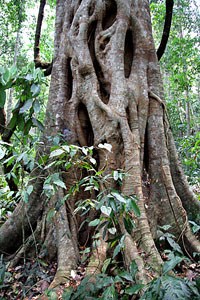
Thailand stretches 1650 kilometers (1025 miles) north to south and thus encompasses a variety of habitats; which results in impressive diversity. While visitors will often encounter seemingly endless rice paddies, tropical forest is the natural cover. Monsoon forest, which features deciduous trees and endures a long dry season, covers the north while the south has true evergreen rainforest. Together they host 1,200 species of orchid, with 150 being endemic to Thailand, and 60 species of bamboo. Where it hasn’t been cut down, mangrove forest lines the coasts. In the middle of the 20th century, forest covered a little over half of the country, but logging along with high population density and rapid development depleted this to about 25% by 1989 when a ban on commercial logging reduced the destruction and the deforestation rate today is just 0.2% per year. Thailand has 148 national parks and another 1000+ official forest and wildlife preserves that together cover 17% of the nation’s land (the highest percentage of any country in Asia) and for the most part protect these habitats; although encroachment remains a serious problem.
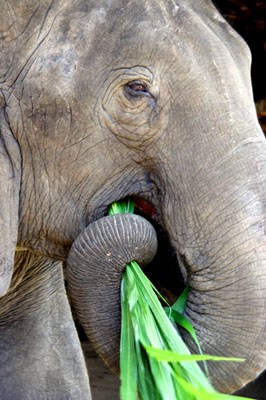
The forest’s most famous resident is the elephant, Thailand’s national symbol, and sightings of wild tuskers in the national parks are more common than you might expect. Domesticated elephants, made redundant by machinery, now roam many cities with their owners who make a living by selling sugarcane to people to feed them. The 200-250 estimated remaining wild tigers, on the other hand, are virtually never seen, except by persistent poachers. Other large mammals include clouded leopard, civet, Malaysian sun bear, gaur, tapir, barking deer and many primates such as acrobatic gibbons and mischievous macaques. Many of the latter live alongside humans in parks and temples. Bird watchers have a chance at nearly 1000 resident and migratory species – almost 10% of the world’s total. The great hornbill, which has a giant beak and sounds like a steam train as it flies, is one of the most exciting sightings. You have to be very lucky to see reticulated pythons, the world’s longest snake (they can grow up to 10 meters/33 feet, but 6 meters/20 feet, is normal) or king cobras, the world’s longest venomous snake (up to 5.5 meters/18 feet), but you will surely see and hear geckos which are common city dwellers. Even two-meter-long monitor lizards have made a home in some urban parks including Lumphini in Bangkok. Notable sea-dwellers include coral, sea turtles, Bryde’s whales, dolphins, and a few dugongs (aka manatees). There are a few spots where 12-meter (39 feet) long whale sharks are regularly encountered by divers. The severely endangered Mekong giant catfish is the world’s biggest freshwater fish: the largest recorded specimen was 2.7 meters (9 feet) long and weighed 293 kilograms (646 pounds).
Tourism
Thanks to an enviable combination of varied attractions, tropical climate, low costs, and renowned hospitality, Thailand attracts around 15 million visitors a year; though becoming a tourism powerhouse has done little to dilute its exotic appeal once you get away from the busiest tourist areas. Beach resorts remain the primary draw, but active travelers who want to explore natural and cultural wonders have no shortage of opportunities. From trekking to cooking classes to scuba diving to elephant camps to whitewater rafting to farm tours to cave trips to ancient ruins to rock climbing, the choices are nearly limitless. In recent years, medical tourism, meditation retreats, and spa and golf getaways have grown in popularity.
Food

Thai food is a diverse cuisine with influences coming from China, India, Europe, Japan, and, of course, all of Thailand’s neighbors. Plus there are significant regional variations: a dinner spread in Nahkhon Phanom in the northeast (Isan) will be very different from one in Satun in the far south. The goal of a standard Thai meal is a harmonious blend of sweet, sour, salty, bitter, and spicy. (This does not apply to individual dishes, even though many books and articles about Thai food say otherwise.) Despite its reputation, typical Thai food is not very spicy. The real heat generally only gets turned on in dishes originating in the northeast (for example, som-tam/spicy papaya salad) and the south (gang dtaai bplaa/southern fish curry). See the About Isan section below for more information about Isan food.
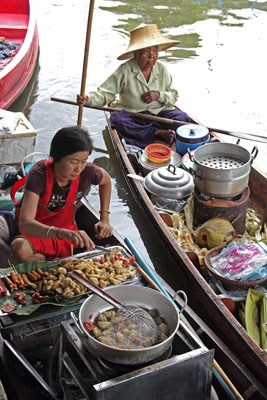
A typical meal will include a clear soup (gang juet/clear soup), something steamed (bplaa nueng manaao/steamed fish in lime sauce) or fried (gang som bplaa chon tawt/deep fried striped snake-head fish in hot and sour tamarind soup), a variety of dipping sauces with vegetables, and usually sweets and/or fruits for dessert. Because early Thais migrated and settled along rivers, fish, crabs, and shrimp have always been the primary protein in Thai cooking: the popularity of pork is a relatively recent development. For quick meals Thais usually eat stir-fries (kao pat gang kiaow wan/fried rice with green curry or the famous pat thai) or rice and noodle soups (guway-dtiaow). Meals are social events and food is ordered for a group and shared by all. Thais generally eat with a fork and spoon; the former used to push food onto the latter. Chopsticks are pretty much only used for eating noodle soups, though some people also use them for pat thai.
Eating vegetarian is considered odd by most Thais, but it’s easy to do here – especially if you don’t mind a bit of fish sauce or shrimp paste in your food. Most cities have “jae” buffet restaurants that go beyond vegetarian by serving vegan dishes that also lack certain strong flavors like onion and garlic. Western food is widely available in all big cities and tourist towns and not hard to find in ordinary cities, Vietnamese restaurants are common in northeastern towns along the Mekong River, and Chinese food is available everywhere.
If you are interested in food, have a look at our Taste of Isan Food Tour, Forest Food Tour, and cooking classes.
About Isan

The 20 provinces of Northeastern Thailand, a region known as Isan (sometimes spelled Isaan, Issan, Isarn, Esan, E-San, Esaan, E-Saan, Esarn, and E-sarn), accounts for one-third of Thailand’s population and territory, but as the poorest region it generates only 10% of GDP and the per capita income is one-third the national average. Isan is wrapped by the Mekong River to the north and east, where it borders Laos, with the Dongrak Mountains on the border with Cambodia to the south and the Phetchabun and Sankamphaeng mountain ranges dividing Isan from the rest of Thailand to the west. It covers 168,734 sq. kilometers (65,149 sq. miles), about the same size as Florida or twice the size of Austria, and covers most of the broad Khorat Plateau with a few small mountain ranges and the two longest rivers in Thailand, the Chi and Mun.
There are several large cities, but Isan remains overwhelmingly rural. Though the soil is relatively infertile and frequent floods and droughts often disrupt harvests, agriculture remains the backbone of the economy. About half the population works full time in agriculture and another quarter does farm work part-time to supplement their primary incomes. Rice is the main crop (sticky rice for home use and often jasmine as a cash crop) accounting for around 60% of cultivated land, but sugar cane, cassava, and rubber are the main money makers. Tobacco and cotton are other notable crops while cattle and dairy farming are on the rise. Industry (mostly food processing, but increasingly manufacturing of clothing and other products bound for Western markets) and service sectors are now growing much faster than agriculture and are opening up new employment opportunities. Though there are still hundreds of thousands of migrant workers in Bangkok (most of the cab drivers and laborers working there come from Isan) and overseas. Many villages have a noticeably small number of men between the ages of 20 and 60 living there.
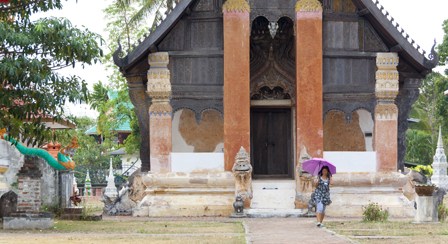
Though Bronze Age communities such as Ban Chiang were highly advanced societies for their time, the region was sparsely populated and there was never a major power centered here; rather it lived under the sway of surrounding empires. Early on the Chenla and Dvaravati empires had some degree of influence, but it probably wasn’t very strong. The Khmers fully controlled the region from around the 9th to the 14th centuries and were then replaced by Lan Xang, from the north. Starting in the late 18th century, conflict amongst the various Lao kingdoms led many Lao leaders and their subject to flee to Isan where they strategically accepted rule by the increasingly strong Siam kings in Bangkok; though they maintained a large degree of independence. As the French snatched up land in Indochina, the Thais realized the importance of Isan as a buffer zone and during the 20th century started to exercise stronger control over the region, both politically and culturally, and locals started to assimilate into Thai culture: whether they wanted to or not.
The central government made little effort to develop the region until the 1960s and 1970s when this was determined to be a good strategy to thwart communist activities and during this time many new roads, schools, and hospitals were built (mostly with money from the USA) and there were low-interest loan, health, education, and agricultural programs developed for locals. Several large US Army bases were also built in Isan at this time and they provided important training and job opportunities to locals.
Though there are now many ethnic Thais (plus significant numbers of Khmer, Kui, Phu Thai, Tai Dam, Chinese, Vietnamese, and other peoples) living in Isan, the population remains predominantly Lao and the Isan language, essentially the same as the Lao language but using the Thai script and many borrowed Thai words, is still a much more common first language than Thai. In fact, there are probably more ethnic Lao in Isan than all of Laos. The people of Isan have a well-earned reputation for their hospitality, work ethic, and sense of humor. Though for much of recent history, because they lived under the thumb of the dominant and often demeaning central Thais, the people of Isan learned to look down on their culture, but there is now a resurgence in respect for old traditions and a growing collective self-confidence. Even some young village men don the stereotypical pa-kao-ma (a colorful and practical fabric worn around the waist) as a badge of pride. There is also a much greater appreciation of Isan’s simple lifestyle amongst the frenzied residents of Bangkok.

Like the language, Isan cultural fundamentals such as festivals, temple architecture, and cuisine are mostly an amalgamation of Lao and Thai. Three well-known foods that most foreigners think of as Thai – som-tam (spicy papaya salad), gai yang (grilled chicken), and laap (usually described as minced meat salad, but really it is a mix of herbs and roasted rice powder that can be made with many bases, from pork to mushrooms to noodles) – actually come from Isan where the local versions are spicier than what is eaten by Bangkokians. While Thai food is rarely more than a little spicy, cooks in Isan don’t skimp on chili peppers and dishes are often fiery. Freshwater fish, like catfish (bplaa duk) and striped snakehead (bplaa chorn) feature at most communal meals. In Isan, most food is eaten with sticky rice (kaao niiao) rather than the steamed kind used in central Thailand. It is also noteworthy that kon isan (“Isan people”) love to snack on insects: crickets, grasshoppers, bamboo worms, silk worm larvae, giant water bugs, and more are found in all night markets and many roadside stalls. Ant eggs are really quite nice in an omelet and this is a common option in restaurants, though it’s rarely included on English-language menus.
For tourism, there are three primary draws: national parks, Khmer ruins, and the simple traditional way of life far from Thailand’s well-trod tourist trail. Isan is also the home of the best Thai silks, made famous around the world by Jim Thompson and still woven by hand under countless village homes.
About Khon Kaen

Khon Kaen city (pop. 145,000), the capital of Khon Kaen province, lies near the heart of Isan, 450 kilometers (280 miles) from Bangkok along Highway 2, the “Friendship Highway.” The city was established in 1789 during the reign of King Rama I, though it didn’t really amount to much until recent decades. These days it’s a rapidly growing and developing commercial, financial, educational, and political hub and has grown into the unofficial capital of the Isan region. Recently the government has worked to make it an export center for Indochina and hence Laos, Vietnam, and China have opened consulates here.
Khon Kaen city is well connected to Bangkok and the rest of Thailand by air, road, and rail and has a range of lodging, dining, shopping, and nightlife wide enough for all tastes, making it a very convenient base for visiting Isan. Locals and visitors alike love to spend time around Bueng Kaen Nakhon lake on the south side of the city which is surrounded by restaurants, shrines, and walking paths. Other tourist attractions include beautiful temples like Wat Nong Wang with its gorgeous nine-story stupa and Wat Pho Ban Nontan with interesting sculptures; a pair of good museums; and some of the best Isan handicraft shops in the region. Several colleges and universities are based here and these give Khon Kaen, like all good university towns, a youthful, vibrant vibe. Most notable among them is Khon Kaen University, the largest university in Isan and one of the best in Thailand, which has a student population of nearly 30,000.
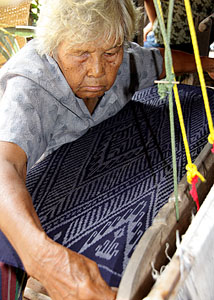
Khon Kaen province covers 10,886 sq. kilometers (4203 sq. miles), roughly the same size as the state of Connecticut or half the size of Wales. It has a total population of about 1,740,000 making it the third most populous province in Isan and the fifth in Thailand. Despite this, the province is still overwhelmingly rural and farming is still the primary livelihood. Several previously unknown species of dinosaur have been unearthed in the Phu Wiang region including Siamotyrannus isanensis, an early ancestor of Tyrannosaurus Rex, and Phuwianggosaurus sirindhornae, named after the deeply beloved Princess Sirindhorn. These discoveries explain the plethora of dinosaur statues found around Khon Kaen city. The province is also famous for tie-dyed mat-mee silk fabric from the town of Chonnabot and the fearless cobra handlers from Ban Khok Sa-Nga (the “King Cobra Village”) who perform shows all around the country. The provincial flower is the Golden Shower Tree (Cassia fistula), which is also the national flower. Khon Kaen’s most famous son is former world top-ten tennis player Paradorn Srichaphan.
Links We Like
Birds of Thailand
• A huge collection of bird photos.
Department of National Parks, Wildlife & Plant Conservation
• Information about Thailand’s national parks.
Eating Thai Food
• A fun and informative blog about Thai food.
Rama IX Art Museum
• Information on artists, galleries, and more about the Thai art world.
Richard Barrow in Thailand
• A blog about travel, culture, and current events.
Thailand by Train
• A good overview of Thai Buddhist temples.
Tim’s Thailand
• My blog about Thai culture, food, and travel.
She Simmers
• Home of one of the most authoritative and respected writers on Thai food.
Volunteer Work Thailand
• A long list of volunteer opportunities across Thailand.
WWF Thailand
• Information about environmental threats in Thailand.
